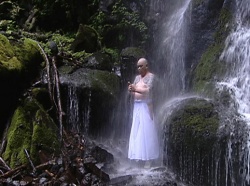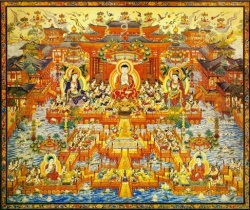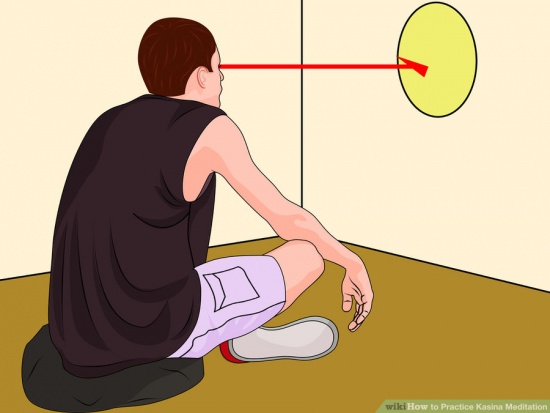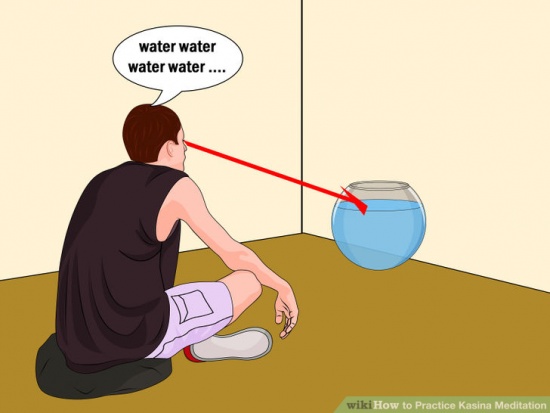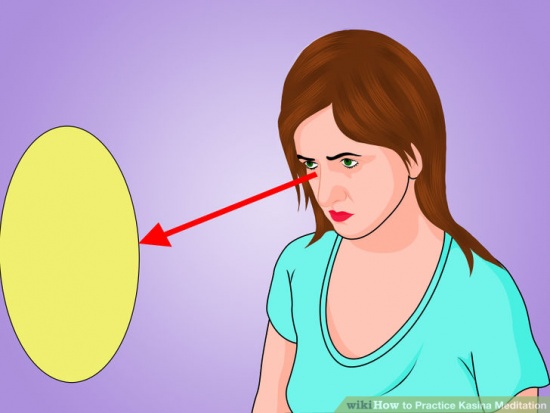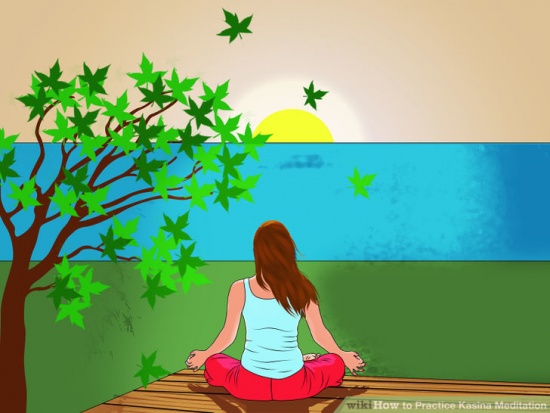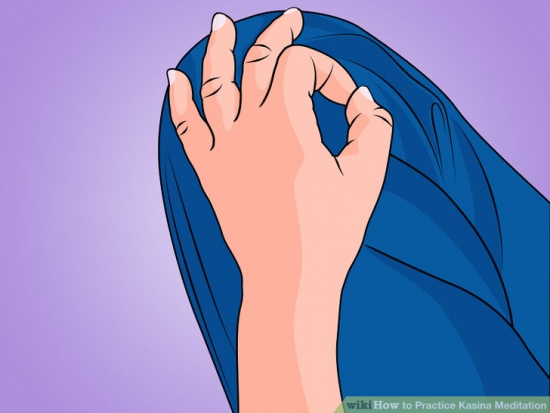Difference between revisions of "How to Practice Kasina Meditation"
| Line 1: | Line 1: | ||
<nomobile>{{DisplayImages|1447|225|3211}}</nomobile> | <nomobile>{{DisplayImages|1447|225|3211}}</nomobile> | ||
| − | |||
| − | |||
| − | In one of the best source [[books]] of the [[subject]], known as the [[Visuddhi Magga]], it gives examples how a [[person]] [[knows]] for themselves if its the right type for them. An example was someone gazing at a display of [[flowers]] noticed that a certain {{Wiki|colour}} stood out vastly more apparent than the others, even when they closed their [[eyes]]. For some it was simply gazing at a candle or into [[space]] and noticed that it suddenly became visually different. | + | |
| + | Out of the 40 [[meditation subjects]] the [[Buddha]] [[taught]] and encouraged, [[Kasina meditations]] take up 10 of them. | ||
| + | |||
| + | These are known simply as [[earth]], [[water]], [[fire]], [[wind]], blue, [[yellow]], [[red]], white, [[space]] and {{Wiki|light}}. | ||
| + | |||
| + | In practice these [[meditations]] have limited [[insight]] value, so are mostly [[taught]] as a means to develop [[concentration]] to be then used as an investigative tool. | ||
| + | |||
| + | It is because there is no one size fits all [[meditation]], some practitioners are more inclined and naturally {{Wiki|adept}} at certain types than others. | ||
| + | |||
| + | The large range of 40 gives a more user-specific option. | ||
| + | |||
| + | In one of the best source [[books]] of the [[subject]], known as the [[Visuddhi Magga]], it gives examples how a [[person]] [[knows]] for themselves if its the right type for them. An example was someone gazing at a display of [[flowers]] noticed that a certain {{Wiki|colour}} stood out vastly more apparent than the others, even when they closed their [[eyes]]. | ||
| + | |||
| + | For some it was simply gazing at a candle or into [[space]] and noticed that it suddenly became visually different. | ||
In {{Wiki|modern}} times, qualified [[meditation]] instructors who know which [[meditation]] is suitable for each [[person]] are rare so [[meditations]] such as [[Kasina]] types are often left for the more experimental practitioners [[interested]] in finding out what place they fit into the range of [[meditations]]. | In {{Wiki|modern}} times, qualified [[meditation]] instructors who know which [[meditation]] is suitable for each [[person]] are rare so [[meditations]] such as [[Kasina]] types are often left for the more experimental practitioners [[interested]] in finding out what place they fit into the range of [[meditations]]. | ||
Therefore this article looks at how to start a [[kasina practice]] and how to develop it. | Therefore this article looks at how to start a [[kasina practice]] and how to develop it. | ||
| + | |||
==Method 1<br/>Making the [[Kasina]] Disc == | ==Method 1<br/>Making the [[Kasina]] Disc == | ||
| − | Firstly, make your [[kasina]] disc. It is best to select one of them that [[feels]] good to you, or one that you know had been apparent to you at some time or another, even if it seemed coincidental. Some prefer a blue disc over a [[red]] one, some prefer the study of {{Wiki|light}} over the study of [[fire]]. As it is all [[relative]] to each [[person]] there is no distinctly right or wrong, there is simply ones that will be effective and ones that won't. All practitioners will vary subtly and in the same way they need to choose the right one for themselves if a qualified instructor cannot recommend one for them. Its recommended to avoid ones which have little appeal as the [[practitioner]] will be spending some time observing it. Here's some basic instructions and suggestions to make your [[own]]: | + | |
| + | Firstly, make your [[kasina]] disc. It is best to select one of them that [[feels]] good to you, or one that you know had been apparent to you at some time or another, even if it seemed coincidental. Some prefer a blue disc over a [[red]] one, some prefer the study of {{Wiki|light}} over the study of [[fire]]. | ||
| + | |||
| + | As it is all [[relative]] to each [[person]] there is no distinctly right or wrong, there is simply ones that will be effective and ones that won't. | ||
| + | |||
| + | All practitioners will vary subtly and in the same way they need to choose the right one for themselves if a qualified instructor cannot recommend one for them. Its recommended to avoid ones which have little appeal as the [[practitioner]] will be spending some time observing it. Here's some basic instructions and suggestions to make your [[own]]: | ||
* For the colours (blue, [[yellow]], [[red]] & white) it easiest and cheapest out of a coloured piece of card sourced from a craft store or news agency. It is better to visit a craft store as the range of each {{Wiki|colour}} from {{Wiki|darkness}} to {{Wiki|light}} as well as blended {{Wiki|colour}} tone may seem more preferable to you than another similar tone of the same {{Wiki|colour}}. Use a dinner plate as a template to cut out a round disc. You can also paint a spot on the wall, but a card is simple to obtain and easier to keep tidy. | * For the colours (blue, [[yellow]], [[red]] & white) it easiest and cheapest out of a coloured piece of card sourced from a craft store or news agency. It is better to visit a craft store as the range of each {{Wiki|colour}} from {{Wiki|darkness}} to {{Wiki|light}} as well as blended {{Wiki|colour}} tone may seem more preferable to you than another similar tone of the same {{Wiki|colour}}. Use a dinner plate as a template to cut out a round disc. You can also paint a spot on the wall, but a card is simple to obtain and easier to keep tidy. | ||
| − | * Image titled Practice [[Kasina Meditation]] Step | + | |
| + | * Image titled Practice [[Kasina Meditation]] Step | ||
| + | |||
* "[[Earth]]" is a {{Wiki|light}} coloured clay disc and in {{Wiki|modern}} times, the most easily sourced {{Wiki|equivalent}} would be a {{Wiki|light}} coloured. unused pizza stone, which may be purchased cheaply from homeware stores. | * "[[Earth]]" is a {{Wiki|light}} coloured clay disc and in {{Wiki|modern}} times, the most easily sourced {{Wiki|equivalent}} would be a {{Wiki|light}} coloured. unused pizza stone, which may be purchased cheaply from homeware stores. | ||
| − | * Image titled Practice [[Kasina Meditation]] Step | + | |
| + | * Image titled Practice [[Kasina Meditation]] Step | ||
| + | |||
* "[[Water]]" is a [[bowl]] of [[water]], but ensure the {{Wiki|colour}} of the container doesn't become the focus as you need to maintain [[awareness]] of [[water]]. A plain, pattern-free [[bowl]] is recommended. Some practitioners focus on a teacup worth, for some it is more apparent when watching the sea. It is important to note that one is not better than the other, as it is [[relative]]. | * "[[Water]]" is a [[bowl]] of [[water]], but ensure the {{Wiki|colour}} of the container doesn't become the focus as you need to maintain [[awareness]] of [[water]]. A plain, pattern-free [[bowl]] is recommended. Some practitioners focus on a teacup worth, for some it is more apparent when watching the sea. It is important to note that one is not better than the other, as it is [[relative]]. | ||
| − | * Image titled Practice [[Kasina Meditation]] Step | + | |
| + | * Image titled Practice [[Kasina Meditation]] Step | ||
| + | |||
* "Light" is easiest with {{Wiki|light}} shining on the floor, particularly if it is an unpatterned floor such as a white carpet, lino or tile. Another good option is large board with a hole in the centre position very much like a pinhole camera so the {{Wiki|light}} shines through the hole onto the ground or a wall, this image on the ground or wall is the [[object]] of focus. | * "Light" is easiest with {{Wiki|light}} shining on the floor, particularly if it is an unpatterned floor such as a white carpet, lino or tile. Another good option is large board with a hole in the centre position very much like a pinhole camera so the {{Wiki|light}} shines through the hole onto the ground or a wall, this image on the ground or wall is the [[object]] of focus. | ||
| − | * Image titled Practice [[Kasina Meditation]] Step | + | |
| + | * Image titled Practice [[Kasina Meditation]] Step | ||
| + | |||
* "[[Fire]]" is easiest with a candle, or a glass fronted [[wood]] stove. Aim to ensure your [[eyes]] do not get tired by heat exposure, or its [[brightness]]. | * "[[Fire]]" is easiest with a candle, or a glass fronted [[wood]] stove. Aim to ensure your [[eyes]] do not get tired by heat exposure, or its [[brightness]]. | ||
| − | * Image titled Practice [[Kasina Meditation]] Step | + | |
| + | * Image titled Practice [[Kasina Meditation]] Step | ||
* "[[Wind]]" and "[[space]]" needs nothing at all apart from [[space]] in the [[air]], or [[wind]] in the [[trees]]. This one can be practiced anywhere outside. | * "[[Wind]]" and "[[space]]" needs nothing at all apart from [[space]] in the [[air]], or [[wind]] in the [[trees]]. This one can be practiced anywhere outside. | ||
| − | * Image titled Practice [[Kasina Meditation]] Step | + | |
| + | * Image titled Practice [[Kasina Meditation]] Step | ||
| + | |||
* The size is also variable. A dinner plate size is OK, but you can make it smaller or larger according to what works for you. Too large may be a [[distraction]], too small may be difficult to focus on. | * The size is also variable. A dinner plate size is OK, but you can make it smaller or larger according to what works for you. Too large may be a [[distraction]], too small may be difficult to focus on. | ||
| + | |||
==Method 2<br/>Starting the [[Meditation]] == | ==Method 2<br/>Starting the [[Meditation]] == | ||
| + | |||
[[File:Aid859169-900px-Practice-Kasina-Meditation-Step-2.jpg|thumb|centre|550px|]] | [[File:Aid859169-900px-Practice-Kasina-Meditation-Step-2.jpg|thumb|centre|550px|]] | ||
| − | |||
| − | Position your disc in a place you can sit and see it comfortably without developing any discomfort in the neck, shoulders etc. You can use a chair and many work better with the use of one, however the height is important, as is how far away the [[Kasina]] is. This is [[relative]], but choose a chair that is fairly low and will not strain the neck and the [[kasina]] should be close enough to be able to focus firmly on it, so neither too close nor too far. | + | |
| + | Position your disc in a place you can sit and see it comfortably without developing any discomfort in the neck, shoulders etc. You can use a chair and many work better with the use of one, however the height is important, as is how far away the [[Kasina]] is. | ||
| + | |||
| + | This is [[relative]], but choose a chair that is fairly low and will not strain the neck and the [[kasina]] should be close enough to be able to focus firmly on it, so neither too close nor too far. | ||
[[File:Aid859169-728px-Practice-Kasina-Meditation-Step-3.jpg|thumb|centre|550px|]] | [[File:Aid859169-728px-Practice-Kasina-Meditation-Step-3.jpg|thumb|centre|550px|]] | ||
| − | + | ||
Observe the [[characteristic]] of your disc, such as repeating [[mentally]] "[[water]], [[water]]" or "[[space]], [[space]]" etc. You can use any [[word]] that appeals or [[feels]] relevant, but English only has limited words for things like {{Wiki|light}}, the colours, [[water]] etc. | Observe the [[characteristic]] of your disc, such as repeating [[mentally]] "[[water]], [[water]]" or "[[space]], [[space]]" etc. You can use any [[word]] that appeals or [[feels]] relevant, but English only has limited words for things like {{Wiki|light}}, the colours, [[water]] etc. | ||
| Line 46: | Line 78: | ||
[[File:Aid859169-728px-Practice-Kasina-Meditation-Step-4.jpg|thumb|centre|550px|]] | [[File:Aid859169-728px-Practice-Kasina-Meditation-Step-4.jpg|thumb|centre|550px|]] | ||
| − | + | ||
Gaze gently at the disc and [[relax]] into it, as strong, rigid focus can create strain which can be a [[hindrance]]. Problematically for many is that the image most often appears when we aren't paying it too much [[attention]], such as when in day to day [[life]] we're gazing into [[space]] a shadow image just happens. [[People]] who have been good at hidden picture puzzles or other optical puzzles have a head start as they are already familiar with persistent focus. | Gaze gently at the disc and [[relax]] into it, as strong, rigid focus can create strain which can be a [[hindrance]]. Problematically for many is that the image most often appears when we aren't paying it too much [[attention]], such as when in day to day [[life]] we're gazing into [[space]] a shadow image just happens. [[People]] who have been good at hidden picture puzzles or other optical puzzles have a head start as they are already familiar with persistent focus. | ||
| − | * Eventually an image will arise from it, it might appear floating in front of the disc, or be the reverse image of it. It might move, or it might be still. This can take some time so it is best not to practice this style of [[meditation]] if you cannot dedicate some real time to it. Common history tells the story of a man who spent 40 days in the desert and developed [[ | + | * Eventually an image will arise from it, it might appear floating in front of the disc, or be the reverse image of it. |
| − | * Image titled Practice [[Kasina Meditation]] Step | + | |
| + | It might move, or it might be still. This can take some time so it is best not to practice this style of [[meditation]] if you cannot dedicate some real time to it. | ||
| + | |||
| + | Common history tells the story of a man who spent 40 days in the desert and developed the [[earth kasina]] and some [[monks]] spend many months on the [[subject]]. It might not happen immediately or quickly, so giving fair time is important to find out and to develop what does arise. | ||
| + | |||
| + | |||
| + | * Image titled Practice [[Kasina Meditation]] Step | ||
* Refrain from forcing it to do something, or trying to change it as that becomes the new focus of [[attention]], not the [[kasina]] you've been studying. They arise easier if you don't try to make it happen but just [[relax]] into it. This is why they happen on their [[own]] sometimes in day to day [[life]]. | * Refrain from forcing it to do something, or trying to change it as that becomes the new focus of [[attention]], not the [[kasina]] you've been studying. They arise easier if you don't try to make it happen but just [[relax]] into it. This is why they happen on their [[own]] sometimes in day to day [[life]]. | ||
| Line 90: | Line 128: | ||
* A [[casual]] observer will note the similarity of {{Wiki|hypnosis}} to this. Actually the two are really very similar. Hypnosis is the focus on an [[object]] until you reach [[absorption]] and both [[mental]] and [[physical]] deep [[relaxation]]. [[Meditation]] uses this as a means to an end - the way to develop [[insight]] and [[mental development]]. | * A [[casual]] observer will note the similarity of {{Wiki|hypnosis}} to this. Actually the two are really very similar. Hypnosis is the focus on an [[object]] until you reach [[absorption]] and both [[mental]] and [[physical]] deep [[relaxation]]. [[Meditation]] uses this as a means to an end - the way to develop [[insight]] and [[mental development]]. | ||
| + | |||
* The [[mind]] also needs to be developed and [[calmed]]. It is sometimes 3 or 4 days or more of almost nothing but [[meditation practice]] such as [[breath meditation]], [[loving kindness]] etc) before the [[mind]] lets go of its [[hindrances]] and can be turned towards developing these. | * The [[mind]] also needs to be developed and [[calmed]]. It is sometimes 3 or 4 days or more of almost nothing but [[meditation practice]] such as [[breath meditation]], [[loving kindness]] etc) before the [[mind]] lets go of its [[hindrances]] and can be turned towards developing these. | ||
| + | |||
* Should you be able to develop [[absorption]], keep practicing it, rather than let it lapse or treat it trivially because it might not come back - ever. The [[Buddhist]] analogies explain that the ones who [[attained]] [[absorption]] in incredible speeds practiced [[kasina]] types. | * Should you be able to develop [[absorption]], keep practicing it, rather than let it lapse or treat it trivially because it might not come back - ever. The [[Buddhist]] analogies explain that the ones who [[attained]] [[absorption]] in incredible speeds practiced [[kasina]] types. | ||
| + | |||
==Warnings== | ==Warnings== | ||
| − | * It is, according to the [[Buddhist]] analogies, the way to develop superhuman [[powers]] or "[[miracles]]". [[Earth Kasina]] for example is said to develop Modification, Extension and Solidification. This is able to turn one [[substance]] into another, to extend a product (the [[Visuddhimagga]] tells the story of a husband and wife who fed a huge crowd out of a cup of pancake batter by extending it) and finally solidification - the ability to turn liquids into solids such as walking on [[water]]. You shouldn't practice these with this aim as you are missing the real goal and can [[cause]] far more [[obstacles]] towards developing [[understanding]]. | + | |
| + | * It is, according to the [[Buddhist]] analogies, the way to develop superhuman [[powers]] or "[[miracles]]". | ||
| + | |||
| + | [[Earth Kasina]] for example is said to develop Modification, Extension and Solidification. | ||
| + | |||
| + | This is able to turn one [[substance]] into another, to extend a product (the [[Visuddhimagga]] tells the story of a husband and wife who fed a huge crowd out of a cup of pancake batter by extending it) and finally solidification - the ability to turn liquids into solids such as walking on [[water]]. | ||
| + | |||
| + | You shouldn't practice these with this aim as you are missing the real goal and can [[cause]] far more [[obstacles]] towards developing [[understanding]]. | ||
{{R}} | {{R}} | ||
Latest revision as of 17:30, 7 March 2016
Out of the 40 meditation subjects the Buddha taught and encouraged, Kasina meditations take up 10 of them.
These are known simply as earth, water, fire, wind, blue, yellow, red, white, space and light.
In practice these meditations have limited insight value, so are mostly taught as a means to develop concentration to be then used as an investigative tool.
It is because there is no one size fits all meditation, some practitioners are more inclined and naturally adept at certain types than others.
The large range of 40 gives a more user-specific option.
In one of the best source books of the subject, known as the Visuddhi Magga, it gives examples how a person knows for themselves if its the right type for them. An example was someone gazing at a display of flowers noticed that a certain colour stood out vastly more apparent than the others, even when they closed their eyes.
For some it was simply gazing at a candle or into space and noticed that it suddenly became visually different.
In modern times, qualified meditation instructors who know which meditation is suitable for each person are rare so meditations such as Kasina types are often left for the more experimental practitioners interested in finding out what place they fit into the range of meditations.
Therefore this article looks at how to start a kasina practice and how to develop it.
Method 1
Making the Kasina Disc
Firstly, make your kasina disc. It is best to select one of them that feels good to you, or one that you know had been apparent to you at some time or another, even if it seemed coincidental. Some prefer a blue disc over a red one, some prefer the study of light over the study of fire.
As it is all relative to each person there is no distinctly right or wrong, there is simply ones that will be effective and ones that won't.
All practitioners will vary subtly and in the same way they need to choose the right one for themselves if a qualified instructor cannot recommend one for them. Its recommended to avoid ones which have little appeal as the practitioner will be spending some time observing it. Here's some basic instructions and suggestions to make your own:
- For the colours (blue, yellow, red & white) it easiest and cheapest out of a coloured piece of card sourced from a craft store or news agency. It is better to visit a craft store as the range of each colour from darkness to light as well as blended colour tone may seem more preferable to you than another similar tone of the same colour. Use a dinner plate as a template to cut out a round disc. You can also paint a spot on the wall, but a card is simple to obtain and easier to keep tidy.
- Image titled Practice Kasina Meditation Step
- "Earth" is a light coloured clay disc and in modern times, the most easily sourced equivalent would be a light coloured. unused pizza stone, which may be purchased cheaply from homeware stores.
- Image titled Practice Kasina Meditation Step
- "Water" is a bowl of water, but ensure the colour of the container doesn't become the focus as you need to maintain awareness of water. A plain, pattern-free bowl is recommended. Some practitioners focus on a teacup worth, for some it is more apparent when watching the sea. It is important to note that one is not better than the other, as it is relative.
- Image titled Practice Kasina Meditation Step
- "Light" is easiest with light shining on the floor, particularly if it is an unpatterned floor such as a white carpet, lino or tile. Another good option is large board with a hole in the centre position very much like a pinhole camera so the light shines through the hole onto the ground or a wall, this image on the ground or wall is the object of focus.
- Image titled Practice Kasina Meditation Step
- "Fire" is easiest with a candle, or a glass fronted wood stove. Aim to ensure your eyes do not get tired by heat exposure, or its brightness.
- Image titled Practice Kasina Meditation Step
- "Wind" and "space" needs nothing at all apart from space in the air, or wind in the trees. This one can be practiced anywhere outside.
- Image titled Practice Kasina Meditation Step
- The size is also variable. A dinner plate size is OK, but you can make it smaller or larger according to what works for you. Too large may be a distraction, too small may be difficult to focus on.
Method 2
Starting the Meditation
Position your disc in a place you can sit and see it comfortably without developing any discomfort in the neck, shoulders etc. You can use a chair and many work better with the use of one, however the height is important, as is how far away the Kasina is.
This is relative, but choose a chair that is fairly low and will not strain the neck and the kasina should be close enough to be able to focus firmly on it, so neither too close nor too far.
Observe the characteristic of your disc, such as repeating mentally "water, water" or "space, space" etc. You can use any word that appeals or feels relevant, but English only has limited words for things like light, the colours, water etc.
- Repeating its characteristic helps focus solely on the subject rather than getting distracted with thoughts.
Gaze gently at the disc and relax into it, as strong, rigid focus can create strain which can be a hindrance. Problematically for many is that the image most often appears when we aren't paying it too much attention, such as when in day to day life we're gazing into space a shadow image just happens. People who have been good at hidden picture puzzles or other optical puzzles have a head start as they are already familiar with persistent focus.
- Eventually an image will arise from it, it might appear floating in front of the disc, or be the reverse image of it.
It might move, or it might be still. This can take some time so it is best not to practice this style of meditation if you cannot dedicate some real time to it.
Common history tells the story of a man who spent 40 days in the desert and developed the earth kasina and some monks spend many months on the subject. It might not happen immediately or quickly, so giving fair time is important to find out and to develop what does arise.
- Image titled Practice Kasina Meditation Step
- Refrain from forcing it to do something, or trying to change it as that becomes the new focus of attention, not the kasina you've been studying. They arise easier if you don't try to make it happen but just relax into it. This is why they happen on their own sometimes in day to day life.
4
Find yourself a quiet place with minimal disturbances if where you are is no longer suitable. Select a comfortable posture and the Do Mindful Meditation page has a look at the four styles to help you select one, although sitting, standing or reclining are the best types. Observe the counterpart image once it is visible (sometimes you will need the eyes shut, sometimes you don't). It depends how well you focused on the original to how well it stays. Sometimes the image might last a few seconds, or a minute, or a fair while. If it fades away, go back and focus on the original again until the symbol appears again. When the image arises, avoid speaking to other people, or using words mentally as that's the easiest way to make the image go away. Its recommended you protect the image as something most precious and to observe it silently with word-less awareness.
5
Keep observing the new image and noting the characteristic. Develop it, enrich it, make it your total focus of attention which does require gentle but consistent and persistent concentration. Some images you can enlarge, some won't - it depends on the type and the person.
- Let everything fade away so there is just the image and relax into it. Eventually the mind becomes fully absorbed into the image, which you can then use to develop insight.
Method 3
Developing the Meditation
To develop it further ensure the mind is calm, bright and aware. Start examining a subject you wish to study deeply. The mind being more calmed is less likely to distort what you are seeing and the deeper focus means it is easier to investigate things more deeply and quickly. Some good subjects would be:
1. The Four Noble Truths
2. The Noble Eightfold Path,
3. Anicca, anatta and dukkha (known as change & impermanence, emptiness & voidness and "Dukkha" standing for stress and dissatisfaction.
4. Cause and effect (Karma)
5. Mindfulness of the mind and body and how they interact with other factors.
6. The application and benefit of letting go and;
7. Application effects of the four Brahma Viharas, also known as goodwill, compassion, appreciative joy and equanimity.
Tips
- A casual observer will note the similarity of hypnosis to this. Actually the two are really very similar. Hypnosis is the focus on an object until you reach absorption and both mental and physical deep relaxation. Meditation uses this as a means to an end - the way to develop insight and mental development.
- The mind also needs to be developed and calmed. It is sometimes 3 or 4 days or more of almost nothing but meditation practice such as breath meditation, loving kindness etc) before the mind lets go of its hindrances and can be turned towards developing these.
- Should you be able to develop absorption, keep practicing it, rather than let it lapse or treat it trivially because it might not come back - ever. The Buddhist analogies explain that the ones who attained absorption in incredible speeds practiced kasina types.
Warnings
Earth Kasina for example is said to develop Modification, Extension and Solidification.
This is able to turn one substance into another, to extend a product (the Visuddhimagga tells the story of a husband and wife who fed a huge crowd out of a cup of pancake batter by extending it) and finally solidification - the ability to turn liquids into solids such as walking on water.
You shouldn't practice these with this aim as you are missing the real goal and can cause far more obstacles towards developing understanding.

